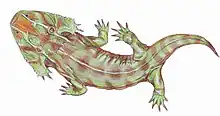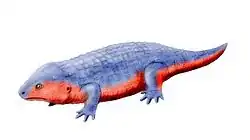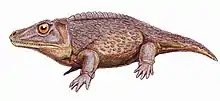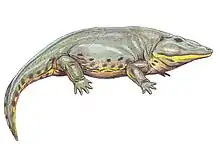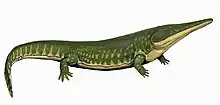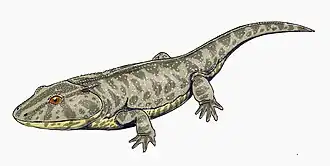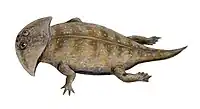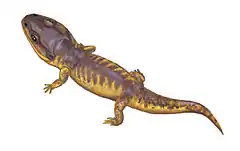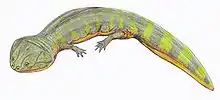Trematosauria
Trematosauria is one of two major groups of temnospondyl amphibians that survived the Permian-Triassic extinction event, the other (according to Yates and Warren 2000) being the Capitosauria. The trematosaurs were a diverse and important group that included many medium-sized to large forms that were semi-aquatic to fully aquatic. The group included long-snouted forms such as the trematosauroids and short, broad-headed forms such as the metoposaurs.[1] Although most groups did not survive beyond the Triassic, one lineage, the brachyopoids, continued until the Cretaceous period. Trematosauria is defined as all stereospondyls more closely related to Trematosaurus than to Parotosuchus, a capitosaurian.[2]
| Trematosauria Temporal range: Early Triassic - Early Cretaceous, | |
|---|---|
 | |
| Skeleton of Anaschisma in the American Museum of Natural History | |
| Scientific classification | |
| Domain: | Eukaryota |
| Kingdom: | Animalia |
| Phylum: | Chordata |
| Class: | Amphibia |
| Order: | †Temnospondyli |
| Suborder: | †Stereospondyli |
| Clade: | †Trematosauria Yates and Warren, 2000 |
| Clades | |
References
- Brusatte, S. L.; Butler, R. J.; Mateus, O.; Steyer, S. J. (2015). "A new species of Metoposaurus from the Late Triassic of Portugal and comments on the systematics and biogeography of metoposaurid temnospondyls". Journal of Vertebrate Paleontology. 35 (3): e912988. Bibcode:2015JVPal..35E2988B. doi:10.1080/02724634.2014.912988. S2CID 84007744.
- Yates, A.M.; Warren, A.A. (2000). "The phylogeny of the 'higher' temnospondyls (Vertebrata: Choanata) and its implications for the monophyly and origins of the Stereospondyli". Zoological Journal of the Linnean Society. 128 (1): 77–121. doi:10.1111/j.1096-3642.2000.tb00650.x.
- Sues, H.-D.; Fraser, N.C. (2010). Triassic Life on Land: The Great Transition. New York: Columbia University Press. p. 236. ISBN 978-0-231-13522-1.
This article is issued from Wikipedia. The text is licensed under Creative Commons - Attribution - Sharealike. Additional terms may apply for the media files.


